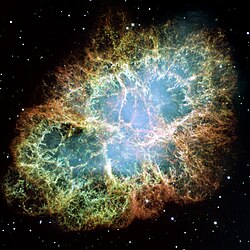Cycle of pulsed gamma rays from the Vela pulsar 220px
Relevantní obrázky



















Relevantní články
PulsarPulsary jsou rotující neutronové hvězdy, které vyzařují elektromagnetické záření. Intenzita záření se pro vzdáleného pozorovatele pravidelně mění, pravděpodobně v souvislosti s rotací hvězdy. Jedná se o takzvaný majákový efekt. .. pokračovat ve čtení
Astronomický objektAstronomický objekt je přirozeně se vyskytující hmotný objekt, útvar nebo struktura, kterou můžeme pozorovat za hranicí zemské atmosféry, v pozorovatelném vesmíru. Astronomické objekty jsou tak hlavním předmětem zkoumání v astronomii a astrofyzice. .. pokračovat ve čtení
